
GLENN LONEY'S SHOW NOTES
By Glenn Loney, October 26, 2001

| |
|
Caricature of Glenn Loney by Sam Norkin. |
|
[02] Shadow-Puppet "Theft of Sita"
[03] Aussie Abo Dances: Bangarra's "Corroboree"
[04] Gross-Out Down Under: "Puppetry of the Penis"
[05] Ovid Transformed: 2nd Stage's "Metamorphoses"
[06] Hispanic Hissy-Fit: "Havana Is Waiting"
[07] Eggs & Sperm: "Immaculate Misconception"
[08] Comic Short-Changed Shakespeare
[09] "Figaro": The Play, Not the Opera
[10] Hilarious "Hedda Gabler"
[11] Laff-Riot "Dance of Death"
[12] Tom Selleck's "Thousand Clowns"
[13] Pay To Pee in "Urinetown"
[14] Sing-Along in "The Spitfire Grill"
[15] "Reefer Madness" Sings
[16] Paper Mill Playhouse's "Chorus Line"
[17] Wagner's "Dutchman" Docks at City Opera
[18] Bellini's R&J: "Capulets & Montagues"
[19] Jonathan Miller's All-White English Seaside "Mikado"
[20] "Strange Birds" Down in DUMBO
[21] New Victory: "Martha" & Camut Band
[22] RENO Rants at LaMaMa
[23] Q&A: "Are You Dave Gorman?"
[24] Curtain Up at Lincoln Center Libe!
[25] Institutional Stage Round-Up
[26] CUNY Theatre PhDs on Stage
[27] Alexis Greene Interviews Women Playwrights
You can use your browser's "find" function to skip to articles on any of these topics instead of scrolling down. Click the "FIND" button or drop down the "EDIT" menu and choose "FIND."
How to contact Glenn Loney: Please email invitations and personal correspondences to Mr. Loney via Editor, New York Theatre Wire. Do not send faxes regarding such matters to The Everett Collection, which is only responsible for making Loney's INFOTOGRAPHY photo-images available for commercial and editorial uses.
How to purchase rights to photos by Glenn Loney: For editorial and commercial uses of the Glenn Loney INFOTOGRAPHY/ArtsArchive of international photo-images, contact THE EVERETT COLLECTION, 104 West 27th Street, NYC 10010. Phone: 212-255-8610/FAX: 212-255-8612.
For a selection of Glenn Loney's previous columns, click here.
Theatre From Down Under:
Australian Astonishments!
Lambs & Pickles Living on Cloudstreet [*****]
Perth Marathon: Neil Armfield Stages Family Epic
The five-hour drama-marathon Cloudstreet—recently at BAM as part of its NEXT WAVE DOWN UNDER festival—was adapted by Nick Enright and Justin Mojo from the popular Australian novel by Tom Winton. It is the saga of twenty years of two quite different families living side-by-side in a huge old house in Perth, at Cloud Street l.This amazingly engaging and wide-ranging family narrative was wonderfully performed by unfamiliar but very talented Australian actors. Their own rehearsal improvs obviously had a lot to do with the effectiveness of many of the scenes.
But the clear through-line of action, the integration of various lives and passions, the swift but sensitive pacing, and the creation of some stunningly theatrical effects are surely to be credited to director Neil Armfield.
I've never been to Perth, let alone Australia, but I already had some sense of Armfield's talents as a director. Some seasons ago, he brilliantly staged Rubenstein's virtually forgotten opera, Der Dämon, for the Bregenz Festival. He's also staged operas for the Welsh and the English National Operas, as well as in Australia.
Long before Cloudstreet arrived in Brooklyn, I'd seen it engage and enchant an Irish audience at the Dublin Festival. This was way back in 1999.
At that time, the production—with fourteen impressive actors playing some forty roles—was already a huge standing-room-only hit in Perth and Sydney. This past summer the show was a big hit at the Holland Festival and elsewhere on tour.
Cloudstreet requires an inclined ramp from the midst of the orchestra onto the stage, so boats and carts and actors can make effective entrances and exits. But the stage is generally bare, adorned with set-props and improvised effects as needed. A rear scrim reveals silhouettes of the cruel woman and her abused girls who once lived in this strange old ghost-haunted house.
Roy Billing is charming and impossible as the often soused horse-race bettor Sam Pickles. Oddly enough, he wins when least expected. And he inherits the huge house—which he is bound not to sell for 20 years—when the family fortunes are at their lowest.
But the Pickles Family cannot afford to pay the bills by themselves, so half the house is rented to the religious, cautious, and impoverished Lamb Family. John Gaden is very affecting as the decent, loving, but somewhat clueless dad, Lester Lamb.
As his rather rigid and resourceful wife, Oriel, Gillian Jones is a force of nature, holding the family together through various disasters.
Their son, Fish Lamb, nearly drowns in a fishing-net. When he's revived, his brain is affected, so he grows up like a child with Downes' Syndrome.
Daniel Wyllie is remarkable in his ability to suggest the physical aspects of such an affliction—while at the same time communicating Fish's fears and longings more through gestures and grimaces than through his fractured speech.
Oriel opens a grocery and notions-shop in the old house, and it prospers. Across the hall, the attractive Dolly Pickles [Kris McQuade] entertains young servicemen, while her often absent or drunken husband pretends he doesn't notice.
Her extremely intelligent and sensitive daughter, Rose [Claire Jones], suffers through the groans and heavings in the next room. As well as from her mother's neglect and cruel jibes.
Rose, through constant reading, really educates herself. She falls in love with an aspiring young author—who ultimately humiliates her for her Cloudstreet background in front of provincial Australian sophisticates.
Fortunately, the Lamb Family's Prodigal Son, Quick Lamb [Christopher Pitman], returns to Cloudstreet. Their childhood proximity and friendship ripens into affection, and the two families are even more firmly bonded.
When I first saw the production in Dublin, I wondered how I'd keep track of so many Lambs and Pickles. Or even how I could get interested in their pathetic little lives and poverty-stricken problems.
But very soon, I found myself completely caught up in their lives and strivings. This wonderful production celebrates The Family, Love, and Continuity.
It was especially welcome at BAM, coming so soon after the terrible tragedy of the Twin Towers, which has brought New Yorkers—even Americans beyond the Hudson River—together as never before.
There was no question—when I found it listed for the fall Next Wave season at the Brooklyn Academy of Music—whether I should see it again. I had just missed it in Amsterdam, and I longed to experience it again.
In fact, here's what I wrote in October three seasons ago in Dublin: "It should certainly be seen in the United States—and not only in New York. But who is going to undertake underwriting a five-hour epic such as this?
"It's the kind of show BAM could do. But its values, stories, and production are so old-fashioned and down-to-earth that they might be out-of-place in BAM's trendy Next Wave avant-garde programs.
"Nonetheless, in humanity and theatrical effectiveness, Cloudstreet puts BAM's recent venture into cutting-edge Family Drama to shame. The Needcompany's pretentious Morning Song was an embarrassing travesty, compared to Neil Armfield's ingenious staging of Cloudstreet."
Shadow Puppets Show The Theft of Sita [*****]
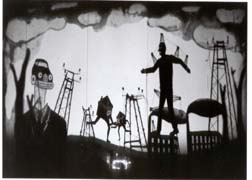
|
|
| SHADOW PUPPETS MEET MODERN TIMES--Scene at BAM from "The Theft of Sita." Photo: ©Julian Crouch/2001. | |
So it was oddly fitting that Nigel Jamieson's Australian adaptation of the tale of the Abduction of Sita was recently presented in the same stage-environment as Brook's masterwork: the once-Majestic but now the Harvey [Lichtenstein] Theatre.
The gods of the Hindu Pantheon are not only looking down on mortals in India. They float over the entire Asian Sub-Continent, extending their gaze to Indonesia and Malaysia—where they seem to share the Cosmos with Allah and Buddha.
With recent immigrations of Asian peoples to Australia, however, its changing and challenging culture has been enriched by infusions from the traditions and rituals of lands and islands to its north. So Vishnu, Shiva, and Krishna now have new spheres of influence.
The essence of the Ramayana is the picaresque and epic tale of the kidnapping and recovery of Sita, abducted by the evil demon Rawanna. In the religious and folk tradition, she represents steadfastness, purity, and the uncorrupted loveliness of the natural world.
Rama is an incarnation of Vishnu, but in his earthly form it is not an easy matter to recover his soulmate. He needs the magic bird, Jataya. And—in the tradition of the Indonesian Wayan Kulit shadow-puppets—the comic servant-clowns, Twalen and Merdah, father and son.
Sita's lover and lord, King Rama, does not figure as largely in Jamieson's The Theft of Sita, as the clown-duo. Their adventures and antics in attempting to find Sita and help free her are the substance of this shadow-drama.
But it is also an indictment of the crushing cruelties of Modern Post-Industrial Society. Of the wastage and corruption of the Environment by profit-driven contemporary free-enterprise Rawannas.
During the corrupt and oppressive Suharto Regime, Wayan Kulit puppeteers used their fantastic two-dimensional images of gods, demons, and men to comment on and react to the abuses. Framed in the ancient tales, with beloved and revered images, their visual indictments were beyond censorship.
In the wake of the World Trade Center disaster, the images at BAM of Shadow High-Rises in a tumultuous and confusing modern city had an added resonance. One they would not have had in Australia, where the relentless incursions of Post-Modernism and Globalization already have had their own resonances in this powerful production.
Indonesian puppets were created by I Made Sidia and family, with contemporary puppet-images by Steve Howarth and Udo Foerster, among others. Paul Grabowsky's musical score—based on traditional modes and performed on traditional instruments, plus a trombone—was a powerful enhancement of the puppet-drama.
Bangarra Dances Corroboree [*****]
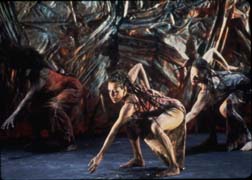
|
|
| ABORIGINAL ROOTS--Bangarra dancers from Australia at BAM. Photo: ©Michael Rayner/2001. | |
The rough riff-raff which shoved them aside, ousted them from their lands—and marginalized them as "Abos"—had no respect or appreciation for their distinctive culture.
In recent years, however, that has been changing. In such sensitive Australian films as Walkabout, the strong contrasts between the native and the imported or manufactured Australian cultures have been strikingly shown.
So it was especially admirable that BAM balanced its outstanding Australian production of poor white families making-do and the shadow-puppet celebration of South-East Asian cultural infusions with the Bangarra Dance Company's kaleidoscopic program of choreographies inspired by the Indigenous Culture.
If anything, the clash of cultures Down Under was even more vividly suggested in the adaptations of native rituals and narratives dealing with such basics as hunting & gathering, nesting, and coming-of-age.
How these age-old impulses and activities can survive in the modern world was explored in movement and music. In performance, however, no attempt was made to translate the choreographies to the backstreets or the main-drags of Australian cities. The entire performance could have been an extended dance-ritual somewhere in the parched, sandy Aboriginal Outback.
Nearly naked male and female dancers were soon covered with rain, sand, and dust as they muscularly rolled, arched, and strutted about, often in very close contact with the dusty stage, as with the primal earth of their tribal roots.
Clearly articulated and sudden movements of limbs, torsos, and heads suggested the characteristic mannerisms of native birds and animals.
Ethnologists have long noted the prevalence of such mimicry—and ritual linkages to the soil—in tribal rituals around the world, where survival depends on natural synergies.
Looking to the heavens and leaping and stretching toward the stars is more often found in cultures which have moved beyond the Hunter/Gatherer Stage.
This vivid and vital production was staged by Stephen Page, a Munaldjali clan descendent and Bangarra's artistic director. Djakapurra Munyarryun was the creative cultural consultant.
Melbourne Genitalia at Work
In Gross-Out Puppetry of the Penis [**]
In case you are not able to get to Manhattan's Theatre Row and the John Houseman
Theatre to see its current attraction, you can check out the website: www.puppetryofthepenis.com
This modest/immodest production—like Cloudstreet—is also from Australia. But five minutes of exposure to the full-frontal-nude exposures of Aussies David Friend and Simon Morley show why BAM did not include it in the Next Wave Down Under festival.
Morley and Friend initially engage their audience—sold-out when I attended—by noting that their show begins where The Full Monty leaves off. As they are wearing capes and sneakers, there is still an element of mystery.
Abruptly, they shed the capes and reveal themselves—as that quaint phrase has it: "As God Made Them."
This unusual show—dare one say "Freak Show"?—was developed in Aussie Pubs. These watering-holes must be much more adventurous than the Irish Pubs which infest Manhattan.
The daring duo call their puppetry-without-puppets "Dick Tricks." They variously contort their penises, testicles, and scrotums into imitations of Big Macs, hot-dogs, mollusks, snails, and wind-surfer sails.
This Frat House/Animal House gross-out entertainment had only one walk-out. The rest of the audience seemed both amused and astonished. One girl shouted out that she wanted to see them erect.
This is a sort of family-show, so Friend and Morley don't do prurient stuff like that. They suggested she should get a demo from her boy-friend.
General chuckles. Or, as they used to say in Burlesque: "A big-titter ran through the audience."
Plays New & Old—
Ovid Transforms Second Stage:
Mary Zimmerman's Metamorphoses [*****]
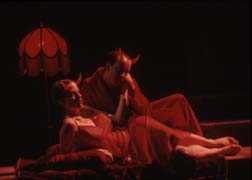
|
|
| SATANIC MAJESTIES--Greco-Roman Gods of the Underworld in "Metamorphoses" at Second Stage. Photo: ©Joan Marcus/2001 | |
I saw this at UC/Berkeley in the Zellerbach Theatre, presented by Berkeley Rep. Although it was a co-production with Chicago's Goodman Theatre and was also shown at the Huntington in Southern California, I still cannot understand why it did not tour widely. Lack of money & bookings, I was told…
Now Zimmerman's enchanting staging of Ovid's Metamorphoses is at the Second Stage. It is, of course, different from the antics of the Monkey King in Journey. But not all that different in its essentials: about desire, change, transformation, magic, even wisdom.
Some of Ovid's tales of transformations and Gifts from the Gods are well known. Almost everyone must have heard of the Midas Touch by now? The abiding love and the open-handed generosity of Baucis & Philemon remain a touchstone.
Some of the Greco-Roman pagan transformations are clearly punishments. Others—although humans may become animals or even trees—are forms of protection. Or they provide a kind of Eternity…
Central to Zimmerman's production is a shallow rectangular pool. Front-row spectators are given towels—which they need.
A lot of water is splashed about, and more of the action seems to be played in the water than around the pool's rim or on the level of the Gods above it.
I wondered if the design—by Daniel Ostling—had been influenced by Arianne Mnouchkine's great pool for Drums on the Dike, recently shown at BAM.
Metamorphoses is such a handsome and charming production it would be an excellent candidate for an Off-Broadway transfer.
Among its attractive and talented cast are Heidi Stillman, Doug Hara, Felicity Jones, Raymond Fox, Anjali Bhimani, Louise Lamson, Lisa Tejero, Kyle Hall, Chris Kipiniak, and Erik Lochtefeld.
The production is currently only a limited-run. Fortunately, it has already been played in Chicago, Seattle, Berkeley, and Los Angeles.
Hispanic Hissy-Fit?
Via Cancun, Havana Is Waiting [***]
Shown last spring at the Humana Festival, Eduardo Machado's split-personality drama of Hispanic Homecoming was then titled When the Sea Drowns in Sand. This was both poetic and pretentious.I did not much like the drama under this name. Nor was it produced to best advantage in the Actors Theatre Louisville's large square arena, the Bingham. Looking down on the three performers in the virtually Empty Space below, it was difficult to connect with them.
Or, put another way, it was easy to glance away from the excesses of emotion, the almost embarrassing queenish rants of the Cuban/American alter-ego of the playwright.
But I did try to be honest in appraising it. Here's what I wrote at that time:
"Eduardo Machado's Habañero…
"Not a great admirer of the playwriting skills of Eduardo Machado, I was not looking forward to his new drama, When the Sea Drowns in Sand. As the production progressed, some of my colleagues nearby were actively hating it.
"Oddly enough—despite all its manifest authorial self-indulgences—I found an affecting core of emotional truth & understandable human reaction in what seems a fictionalized version of an autobiographical experience. Machado clearly did not have an Elian-Experience as a child in America.
"Machado's central character, Federico, is a displaced Cubano—sent off to America as a child—now returned to rediscover a past that cannot be recaptured. His anger and frustration—both as written and as portrayed by Joseph Urla—seem generated out of longing and a strangely out-of-place Sense of Entitlement.
"He is manifestly gay, but is accompanied & supported by his dear friend & best-buddy, Fred [Ed Vasallo], who stubbornly insists he is not gay. They are Just Good Friends.
"Ernesto [Felix Solis], the resourceful, opportunistic, and thoroughly Macho driver who shows them around Havana—as it now is, after years of neglect under Fidel Castro—is clearly irritated by, even uncomprehending of, Federico's occasionally effeminate outbursts.
"This was the aspect of the play and performance which most annoyed—even alienated—some of my critic-colleagues. One insisted that Machado was writing two plays and didn't know it.
"Or that he had at least two agendas: One about being robbed of one's Childhood & Heritage. The other about the problems of being a Gay Latino, whether in Maricon-Hating Cuba or in Gay-Bashing America.
"Michael John Garcés—who is himself a very talented performer—staged sparely, with much being left to the audiences' imaginations."
As it is now largely played within the proscenium-frame of the intimate Cherry Lane Theatre, I found myself more easily drawn into the experience. Though I still hate having actors make entrances and exits up and down the aisles…
Bruce MacVittie has replaced Joseph Urla as Federico, which is a distinct improvement in terms of vitality and presence. But his passions and frenzies at times come close to hissy-fits.
Years ago, that quintessentially American novelist, Thomas Wolfe, recorded his own experience of trying to recapture an imaginatively remembered past in You Can't Go Home Again.
North Carolina's hill-country, of course, is nothing like formerly cosmopolitan Havana. But even if "Home Is Where the Heart Is," you cannot go home again.
Even if the cigars are superb, they will eventually give you lung-cancer. And seeing your childhood home in wretched disrepair will break your heart…
The Pill-Doctor's Play:
An Immaculate Misconception [**]
The press-material identifies playwright Carl Djerassi as the scientist who created The Pill. He seems to have done so well from this discovery that he now devotes himself to philosophic and literary pursuits.Along with my press-tickets to the recent production of his drama, An Immaculate Misconception, at Primary Stages—I received a copy of his book about the Saga of the Pill. It seems an interesting story, in which the good doctor doesn't take the back seat.
His play, however, is more problematic. An unmarried female doctor-researcher—on the actuarial edge of the boundary between fairly safe and dangerous pregnancies—is working on fertilizing ovarian eggs with male sperm.
She is speculating about a time in the future when young women—married or unmarried—could have prime eggs frozen for possible future fertilization. Male sperm would be preserved in the same way, selected for quality.
But right now, she wants to have a child of her own. Preferably with excellent DNA on both sides.
At a medical conference, she beds a vigorous Israeli and gets a condom-full of his sperm to preserve. Unfortunately, he had a radiation accident, so the sperm sample is very weak, possibly infertile.
She enlists the aid and support of her clinic-director in her efforts to fertilize her eggs. While she is briefly out of the lab, he quickly procures some of his own hot and fresh sperm.
So she may never know whether the father of her test-tube baby is Israeli or not.
Fortunately, the drama is framed by her son in his Bar Mitzvah shawl & yarmulke. He, at least, wants to believe he's Jewish. But having been a lab-experiment hasn't been a lot of fun.
What if the lady-doctor had met a Nigerian or Chinese physician at that medical conference? What then?
Did it absolutely have to be an Israeli sperm-donor? Are they somehow more charismatic? Or just more interesting to New York audiences?
Retreat To the Classics—
Look Where It Comes Again!
The Complete Works of William Shakespeare (Abridged) [****]
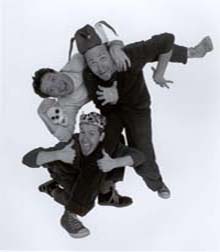
|
|
| SHAKESPEARE'S ABRIDGERS--David Turner, Jeremy Shamos, & Peter Ackerman boil down the Bard. Photo: ©Carol Rosegg/2001 | |
I thought it Shakespeare Parody on the level of Animal House. Or The Bard for Frat Boys who slept through Elizabethan Drama 102A.
Despite my disaffection, it went on to have a long run, become a major and recurrent hit at the Edinburgh Fringe Festival, and settle-in for a long run in London's West End at the Criterion Theatre. Where it is still packing in the tourists, alternating with a much more ingenious and amusing abridgment of American History.
Not only has it been one of the main theatrical attractions in Piccadilly Circus, it has also entered the repertories of leading European drama theatres. National and State Theatres which customarily only present the Classics, Ancient & Modern.
Germany surely has more government-subsidized theatres and ensembles than any other nation in Europe. On those stages, Shakespeare is God. Goethe could be regarded as His Son perhaps…
Some fantasy-prone Germans have even suggested that the Bard may have been born in Germany and smuggled across the English Channel in swaddling-clothes. His Thought, his World-View, his Understanding of Man, his Compassion are all so thoroughly Germanic that he must really have been a German in his cradle!
When the Germans do comedy on their historic stages—especially Bardic comedies—they make sure that it is serious and sedate. Also very louds and forceful. This prevents some ignorant peasants from laughing during the performances.
When Shakespeare Abridged is performed on German stages, however, outstanding Shakespearean actors often present the summaries. With this kind of talent, experience, and dramatic weight, the survey-script of Adam Long, Daniel Singer, and Jess Winfield can be uproarious fun.
Now settling in for what should be a long run at the Century Theatre, it is still sophomoric, but much more professional than the first time round in Manhattan. And it is indeed uproarious fun.
Steven Capone has designed a mock-up of an Elizabethan Theatre which looks very much like the one at the Oregon Shakespeare Festival in Ashland. Markas Henry's costumes contribute to the hilarity, reinforced by the rapid costume-changes of Peter Ackerman, Jeremy Shamos, and David Turner.
This time the show has real Production Values!
But Shakespeare still doesn't fare any better than Wagner did in Anna Russell's famous Square Talk About The Ring.
Beaumarchais—Minus Mozart's Music:
Target Margin's Marriage of Figaro [****]
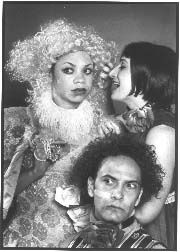
|
|
| FUNNY FACES IN "FIGARO"--Beaumarchais' comedy as reworked by Target Margin. Photo: ©Paula Court/2001. | |
Fortunately, he has avoided revisiting Dido in Hector Berlioz's epic opera, The Trojans. This has defeated major opera-houses. In fact, he has even avoided staging an actual opera for Target Margin's fall premiere.
Instead, he has digested Pierre Augustin Caron de Beaumarchais' revolutionary comedy, Le mariage de Figaro, into a lively & colorful evening's entertainment. Minus Mozart's sublime score, of course.
But also minus Lorenzo Da Ponte's opera-libretto. This is a distinct plus, for some of the sharpest social critiques in Beaumarchais' Figaro were deftly omitted by Da Ponte.
He wisely wished to avoid offending the Austrian Emperor—whose close relative, the King of France, had found the play offensive and seditious. In fact, it even proved a small incitement to the French Revolution.
In the drama, not only Figaro complains of his subjugation—despite his intelligence and skills—to a thoughtless, capricious, vengeful, lustful, autocratic master. But even more plaintive is the list of outrages suffered by women in 18th century society, as outlined by Marceline, who proves to be Figaro's mother.
Da Ponte made a joke of Figaro's frustrations—and even made him a bit of a fool. But he completely cut Marceline's Big Speech. Herskovits restores it in a reduced form.
Unusual stage-environments and delightfully bizarre costumes are a Target Margin trademark. The current production—staged by Herskovits—does not disappoint in this regard. Nor do the ardent thespians of his ensemble.
For some mystic reason, Band-Aids seem to be in vogue this season. Formerly, black X's were rampant, initially inspired by Target Margin's staging of Julian Green's South.
Herskovits explained this to me: American slaves—who were forbidden by law from learning to read and write—signed their names with an X.
The X made its mark on the Dido production as well, but then Carthage was a society based on slavery, was it not?
Crazy Day, or The Marriage of Figaro is all too briefly on view at the Ohio Theatre on Wooster Street.
In Spring, Target Margin will produce an original opera, The Sandman, with a libretto by Herskovits, based on the tale by E. T. A. Hoffmann. Will the cast wear Band-Aids?
Why not? In some of the Gothick-Romantick Tales of Hoffmann, the characters get seriously hurt. Some even die!
Post Scriptum:
I may have over-reacted to Target Margin's Crazy Day. If so, that's possibly because of my long-standing admiration both for the opera and the play.
The omission of Marceline's list of Women's Wrongs in the opera had long bothered me. I understood that this was not an oversight.
Not only was the opera long enough—sometimes over four hours in performance—without it. But it also would have added to the libretto's indirect indictment of the hierarchical, undemocratic system which was then the rule in all European nations, save Switzerland. And England, on occasion…
Having seen an excellent production of a new translation of The Marriage of Figaro some years ago in London, I was once again struck by the neglect of Marceline's just objections to the treatment of women—even in this very English version.
Returning to New York and the Department of Theatre at Brooklyn College, I decided to do something about Marceline's concerns.
Under the banner of Figaro Comes To Flatbush, I was able to commission a new American translation—thanks to a $5,000 grant from France's Services Culturelles and the genius of our translator, Dr. Alex Szögyi, Hunter College Professor of French.
The new version was staged by Toby Robertson, who had just been director of the Old Vic in London. The Music Department prepared scenes from Mozart's opera to show alongside scenes from the play in workshop.
Modern Languages helped by offering some samples of the comedy in French—and of the libretto, in German, no less. We should have added Italian, the language of the original libretto.
As both the play and the opera were being celebrated, both France and Austria contributed to a small-scale exhibition of architecture and style of the period. Plus Austrian wine & cheese!
I neglected to ask the Spanish government to join the project: an unfortunate oversight, as the Almavivas lived on a great estate outside Seville!
Not being affiliated with a college or university, Target Margin obviously cannot explore such elective affinities. But it's still an interesting idea: to experience a work of theatre in its cultural context.
Norse Angst as Social Comedy:
Hilarious Hedda Gabler [***]

|
|
| KATE BURTON AS HEDDA GABLER--A rare moment of quiet. Photo: ©T. Charles Erickson/2001 | |
Nonetheless, director Nicholas Martin and adapter Jon Robin Baitz seem to think that Ibsen's Hedda Gabler has a mordant vein of black comedy running through it.
At least that's the way the tempestuous Hedda of Kate Burton is played. She is an imperious Force of Nature who would be more at home in a Paris Salon than in a fusty old villa in Christiana.
As designed by Alexander Dodge, however, Frau Dr. Tesman's villa is light, airy, attractive. Forget about those long Norwegian nights and the epic boredom of living with a filing-card husband.
Baitz obviously does not read Norwegian, for he drafted his text from a literal translation by Anne-Charlotte Hanes-Harvey. He also seems to understand very little about the society and people of which Ibsen was writing.
Had he only cobbled his script from some of the adequate to excellent translations already available, he might have realized that Hedda is not Shaw's Modern Woman. And she's especially not a Woman for Our Times.
Hedda is a passionately conflicted, confused woman, trapped in a society which has no real place or role for her to play.
Nor is she an exemplar of Shaw's Life Force. Shaw was influenced by Ibsen, not the other way around.
With no talents nor opportunities in provincial Norway to make any kind of a mark, Hedda is totally frustrated. Especially as a woman, although she is the proud, even feared daughter of a famous general.
She longs to exert power in some way. But her dreams and hopes are Romantic—with a capital R—and unreal.
So she becomes a dark, destructive, demonic force. At the Ambassador Theatre, however, the audience was more often laughing than gasping.
As Tesman, Michael Emerson is such a wimp, fool, and general pain-in-the-ass, it's a wonder Hedda didn't drive him to suicide on their fact-finding honeymoon. His oafish interpretation must have been shaped by the director, for he surely cannot be such a Coarse Actor on his own?
Laff-Riot Dance of Death [****]
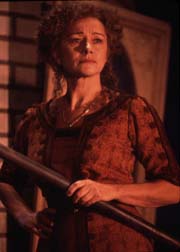
|
|
| HELEN MIRREN AS ALICE IN "DANCE OF DEATH." Photo: ©Joan Marcus/2001. | |
Captain Edgar and his ex-actress wife, Alice, are locked in permanent marital hostilities. Each knows all too well how to hurt the other.
As the Battle of the Sexes is always an Audience-Magnet, this Swedish Totentanz is frequently revived. And just as often, it is played rather too seriously, which makes for a thoroughly painful, poisonous evening for all concerned.
For all his mysogyny—and marital spats with Siri von Essen—Strindberg was often in thrall to women. But he never lost a certain ironic detachment, even in the depths of his own self-inflicted torments.
The outrageous torments Alice and Edgar inflict on each other by turns are so excessive that they do in fact verge on the comic. McKellen, Mirren, and director Sean Mathias understand this very well.
The late Swiss dramatist, Friedrich Dürrenmatt, also understood it when he adapted Dance of Death as Play Strindberg.
This amusing version—structured as a boxing-match, with Strindberg's spats divided into boxing-rounds—proved immensely popular in European and American theatres not so long ago.
Perhaps Mirren and McKellen might like to revive this as a pendant to the current staging?
They would do well to dispense with David Straithhairn as Kurt, whom they mutually torment. As an actor, he doesn't seem to Get It.
Richard Greenberg's adaptation of Strindberg's drama is much more successful than Baitz' version of Ibsen. But then Greenberg is—as evidenced by his previous plays—probably the better playwright.
Tom Selleck's Thousand Clowns [**]
Tom Selleck worked very hard to recreate the role of Herb Gardner's feckless drop-out, Murray Burns, in the recent revival of A Thousand Clowns. But the late Jason Robards had already established a copyright on the performance.Frankly, I never much admired this would-be Boulevard Comedy. And it seemed even more contrived—and certainly dated—in John Rando's retro staging at the Longacre.
As Murray's precocious son, Nick, wound-up & on-cue young Nicolas King was even more obnoxious than most child-performers. In his Playbill bio, he credited Liza Minelli as his inspiration.
When I first met Liza, years ago at the North Shore birthday-party of then piano-prodigy Lorin Hollander, she told me she'd been Lorin's classmate at the Professional Children's School.
Young King hails from Rhode Island, so he seems to have already been a Professional Child before coming to New York.
Musicals Old & New—
Pay To Pee: Urintetown/The Musical [*****]
If You're In Town, See Urinetown!
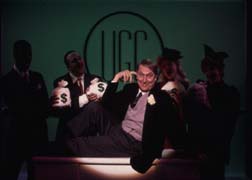
|
|
| PAY TO PEE!--John Cullum as the Baddie in "Urinetown." Photo: ©Joan Marcus/2001 | |
As you may well imagine, the name really put me off. Which is what various members of the cast worry about in the actual show: "Who'd want to see a musical with a name like this?"
But the show's PR people tracked me down and urged me to go. And colleagues—who thought this show, in its own perverse way, to be as good as Batboy the Musical—insisted it was my duty to see it as an Outer Critics Circle Nominator.
The premise—if you've not already read about the production—should give President Bush pause when considering the Future of the Environment. Global Warming is parching the Earth. In Urinetown, there's so little water, taking a pee can cost you your Life's Savings.
[Of course, the President is currently concerned with the Future itself, in which there might not be any Environment left. If some religious fanatics who live and plot where there has always been Very Little Water have their way…]
John Cullum—the very opposite of his heroic persona in the musical Shenandoah—is the Oligarchic Monopolistic Capitalistic Meanie, Caldwell B. Cladwell. He has gained control of all the available water in Urinetown. As well as all the Public Toilets.
To say this show is "in the toilet" is more than a metaphor.
But it's a lot more than that. It is also an obvious parody of Bert Brecht/Kurt Weill 1920s Agit-Prop Music-Theatre works like Mahagonny & Threepenny Opera. This means it has a really jazzy period-score.
It also owes a lot to Elmer Rice's Street Scene, to performance-techniques of the Group Theatre, and Social Protest productions of Theatre Union and other 1930s Socialist/Marxist Trouble-Makers.
The admirable cast acts with the overheated passion of earnest Depression-driven under-employed actors. Almost every gesture is a Social Challenge—a Semaphore, a Call To Arms…
John Rando [Thousand Clowns] directed, with John Carrafa providing musical staging. Mark Hollmann [score] & Gregg Kotis [book] collaborated on the satiric lyrics.
An important extra production-dividend in Urinetown's showcase Off-Broadway staging was mounting it in a shabby second-floor courtroom, next to a midtown police station. It was like watching a Theatre for the Forgotten production for inmates at Riker's Island.
Now installed in Xenon and Cabaret's former venues, the dilapidated but venerable Henry Miller's Theatre, it is visually even more effective.
In addition to Cullom's delightfully malicious performance, there are outstanding turns by Jeff McCarthy, Spencer Kayden, Hunter Foster, and Nancy Opel.
What can Hollmann & Kotis do to top this show? After Urinetown, can Shit City be far behind?
Floyd Collins Revisited?
Playwrights Horizons' Spitfire Grill [***]
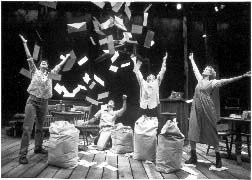
|
|
| BEFORE THE ANTHRAX SCARE--Mail-call in "The Spitfire Grill." Photo: ©Joan Marcus/2001. | |
For that matter, I have yet to see Spielberg's Artificial Intelligence. Or is A. I. the correct title? I was in Europe all summer…
Now that I have experienced the Playwrights Horizons production of the musical version of Spitfire Grill, by James Valcq and Fred Alley, I don't feel so deprived.
In the dim distant 1930s, every Saturday evening we'd gather round the radio to listen to Alka-Seltzer's National Barn Dance, followed immediately on Clear-channel by The Grand Ole' Opry.
So I do have a lurking affinity for Country & Western and the pathetic lives of Trailer Court Losers and people marginalized by poverty, superstition, ignorance, jail-sentences, and living in dying villages in the middle of nowhere.
That is, in fact, my own background, excepting the jail-sentences. But Uncle Ray did go to federal prison for stealing cash & checks from letters when he was Postmaster in Salinas.
He was already a Broken Man, however. He was gassed and wounded in France in World War I. When he got out of prison, President Harry S. Truman pardoned him.
But he didn't live to sing about it, like the heroine in Spitfire Grill.
Actually, the bonding of three women—while keeping the grill open with virtually no customers—is an affecting, if small-scale, epiphany. And the songs are pleasant enough, well sung by the cast, especially its star, Liz Callaway.
Michael Anania's setting of poles and platforms worked well enough. It could be re-cycled for any number of shows. David Saint staged.
Playwrights Horizons is to be encouraged in its workshopping of new American musicals. It tried out Stephen Sondheim's Assassins when no one else would touch it. And, right now, owing to a new breed of assassin, no one still wants to produce it…
The PH staging of the musical Floyd Collins was much admired. Not least because some of Richard Rodgers' DNA was involved in its creation.
Owing to its faithfulness to the historical event of Collins being trapped in a spelunker's nightmare-cave-in—from which he could not be rescued—the show's book developed a split-personality. Collins' bravery and slow death couldn't play off another human-being face-to-face, either confronting him, or trying to help him escape.
Shouting down a shaft isn't the same thing. And the media-circus and tourist-attraction that developed during efforts to save him pulled the script in a different direction.
Spitfire Grill seems to inhabit the same emotionally-starved and economically-endangered American outback as Floyd Collins, though its rural Wisconsin scene is a long way off from our red-neck Southland.
Now how about a musical about the problems of people with SUVs, three TVs, backyard pools, and weekend getaway cabins, but only High School Equivalency Certificates? People who have just been laid off by Boeing or Ford?
They hurt too.
Not Quite Batboy on Pot:
Reefer Madness Sings [***]
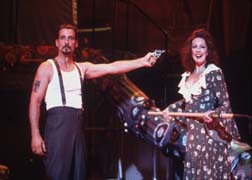
|
|
| GOING TO POT--Robert Torti & Michelle Pawk in "Reefer Madness." Photo: ©Joan Marcus/2001 | |
Oh oh! Is this going to be another Batboy? Or just a wannabe?
Batboy, in any case, is something of a fluke. It is extremely difficult to kid some subjects. But that show has a set of such bizarre premises that one very soon has to abandon—not all Hope—but all expectations of a logical outcome.
Reefer Madness, on the other hand, is trying to kid not only that vintage film of the same name—warning adults more than their teenagers—about the dangers of smoking marihuana. But it also wants to lampoon the Witch-Hunt Hysteria of Harry Anslinger, J. Edgar Hoover, and other Guardians of Public Morals.
In the view of these officials, just one toke would be enough to plunge an unsuspecting teen into a morass of crime, murder, sex, and degradation.
That was certainly overstating the case, as the cinema career of Robert Mitchum demonstrated. He would have looked sleepy-eyed even if he had limited himself to Lucky Strikes and Jack Daniels.
Unfortunately, drug-addiction—which does not necessarily develop from smoking a joint or two—is no laughing matter.
It is a major national social problem, with no clear solution, the War on Drugs having become a dangerous boondoggle abroad. Didn't the CIA once fund the Taliban in this effort?
Nonetheless, the able cast of Reefer Madness works very hard to entertain their audience and make something special of the stereotyped characters, slapstick plot, and the derivative songs of Kevin Murphy and Dan Studney. Paula Abdul choreographed, with staging by Andy Flickman.
Paper Mill's Very Own Chorus Line [****]
Given the short rehearsal-periods and the necessarily short runs, it's unfair to expect a Broadway-quality revival of beloved musicals at the Paper Mill Playhouse.But, in the absence of an American Musical Repertory Theatre—on the order of the New York City Opera, which has just done so brilliantly with Gilbert & Sullivan's Mikado—the Paper Mill is the best and closest stage we have for such revivals.
And the wonder is that they are, in fact, so good: so effectively staged, so well performed, and so handsomely set & costumed!
The recent mounting of A Chorus Line was no exception. True, there was no Donna McKechnie in the ensemble, but the level of energy and talent was very high indeed.
Chorus Line was never about sets or costumes—except for the outfits in the finale. But Robin Wagner, Theoni V. Aldredge, and Tharon Musser's design-skills were once again visible, recalled from Broadway to Millburn, NJ.
My only quibble was with the pacing, as the show seemed to run rather longer than on Broadway. Both director Baayork Lee and conductor Fran Liebergall were culprits in that regard.
Cole Porter's "all new" Red Hot and Blue is the current revival at Paper Mill. There are only 48 performances, as it must close December 2. Millburn is less than thirty minutes from Penn Station on the Midtown Direct train. So why not call for tix: 973-376-4343.
Music-Drama: Nights at the Opera—
City Opera Wagner: The Flying Dutchman [****]
That the New York City Opera is really too lightweight to perform Wagnerian operas properly may be another Urban Legend. Or at least one immediately discredited by this season's interessting production of Der fliegende Holländer.But I am surely not the only one who still remembers the almost hilarious horror of its Flying Dutchman many seasons past? The voices simply weren't up to the vocal challenges: forget about anything resembling acting. Nor was the orchestra ready for Wagner.
I did not save the program, but I seem to recall that Jean-Pierre Ponnelle was responsible for the sets. Correct me if I am wrong about this.
Or is this a misplaced memory of something awful at the San Francisco Opera? Or did NYCO borrow the SFO settings? Is there a website with all this information?
In memory, skeletons of drowned men, and bits of coral, undersea-life, fish-nets, and other flotsam are floating upstage. It looked like Davey Jones' Locker, as fitted out for some Embarcadero Pub.
The very good news now is that the City Opera's new Dutchman is admirable, if not quite Bayreuth or even Munich quality.
Yes, the orchestra could profit from richer sonorities, but under conductor George Manahan, it gave a very good account of itself and of the thundering, turbulent score.
Mark Delavan's doomed Dutchman was an able—if not unforgettable—performance, both vocally and visually. Kevin Langan's greedy, self-satisfied Daland was an effective semi-comic counterpoise to the deadly serious infatuation of Senta for the damned ship-captain.
As the fatally besotted heroine—already idolizing the Dutchman's mysterious portrait: what's it doing in Daland' china-cabinet anyway?—Susan B. Anthony was impressive and impassioned. We might see her in this role someday in Bayreuth.
Even at Bayreuth, Eric is often an annoying cipher. Even if there were no Dutchman looming on the horizon, Senta could be excused for not wanting to marry him.
But as sung and acted by Carl Tanner, he had considerably more dramatic weight and attractiveness than usual. He even elicited sympathy for his painful situation.
The effective dramatic interactions of this good cast surely were developed in rehearsal by director Stephen Lawless. Such powerful moments do not "just happen."
Of course City Opera has neither the budget nor the shops of the Met or Bayreuth. Nor does it have the backstage space nor the stage-machinery to give Dutchman the breathtaking visual effects it invites, requires, even demands.
Nonetheless, set-designer Robert Wierzel has devised handsome but elemental site and ship suggestions which work very well indeed. Highly stylized ships and shores have long been the standard at Bayreuth and on other major opera stages not trapped in 19th century Romanticism.
Dutchman has found a safe haven at the NY State Theatre. And Wagner at last has found a second home at Lincoln Center.
This production should remain in the repertory for a while. Where it might be joined by a similarly stripped-down, stylized Die Meistersinger? Except that this requires too large a cast…
Bellini, Not the Bard:
The Capulets and the Montagues [****]
In addition to the glories of bel canto which embellish the score of this interesting—but all too seldom performed—opera, the librettist, Felice Romani, has created a somewhat different vision from Shakespeare's of the Renaissance tale of star-crossed lovers.Romani returned to the sources which inspired the Bard, but the cast of characters is simplified. And the tragedy works itself out more elementally—and possibly even more powerfully—than in Shakespeare's complex plot.
Romeo and Juliet still die at the end, of course. Romeo is a breeches-role, and Sarah Connolly acquits herself very virily—and handsomely—as this gentle hero. As Giulietta, Mary Dunleavy is a fine romantic and vocal match for Connolly.
As is now the rule at City Opera, the acting performances are as admirable as the musical interpretations. Joseph Rescigno conducted.
This powerful production—staged by Thor Steingraber—is elemental in design. But it's nonetheless effective in suggesting locales, moods, and atmosphere. Credits to set & costume designer Robert Israel and lighting-designer Christine A. Binder.
Bob Israel is, in effect, a Post-Modernist designer, so it's not budget-constraints alone which encourage him to favor simple set-elements and design-geometrics. Tour considerations were obviously also at work. For this is a co-production with the New Israeli Opera—no relation to Bob, the Minnesota Opera, and the Los Angeles Opera.
Titipu as Weston-super-Mere:
Jonathan Miller's English Seaside Mikado [*****]
When I first saw Jonathan Miller's beautiful and daring Anglicizing of Gilbert & Sullivan's The Mikado at the English National Opera, it was already a revival of this hugely successful production.And that was already long ago, before ENO's Intendant, Peter Jonas, went to Munich to head the Bavarian State Opera. And become, in the process, Sir Peter!
Isn't it about time that Dr. Miller was also knighted for his magnificent contributions to the music-theatre? There are already plenty of Theatre Knights called Sir Peter. How about Sir Jonathan?
Not only has W. S. Gilbert's once-hilarious dialogue been updated—and some of his lyrics as well—to make the comedy more immediate and relevant. But the plot and characters also have been whisked away from a fictional D'Oyley Carte Japan to an Edwardian English seaside resort hotel.
This fantastic establishment—with seriously skewed floors, enormous grand-piano, even larger bell-trumpet phonograph, and chairs adorned with musical instruments hanging on the walls—is painted totally Dead White.
Designer Stefanos Lazaridis' decorative style is hilariously poised between Daliesque Art Nouveau and Mrs. Somerset Maughm's All-White Art Deco. Sue Blane's handsome—and often outrageous—costumes are White & Black. Cecil Beaton had a huge success with that for the Ascot Scene of My Fair Lady, but Blane has gone All The Way.
Sue Blane may be better known to fans of Popular Culture as the costume-designer for the film-version of The Rocky Horror Show. More recently, however, she and Lazaridis have again teamed up to design Bayreuth's powerful new Lohengrin production, staged by Keith Warner!
Having seen this production at ENO several times, I was wary that this re-staging might look a bit shop-worn, derivative, copy-cat, and generally lackluster. Seldom are revivals—even with the best intentions—anything like the originals.
The new, new New York City Opera Mikado is like a Broadway Opening-Night!
It is not only bright and fresh, but it's performed with musical magic, hilarious characterizations, marvelous comic-timing, and the vibrant energy and vitality which distinguish such Broadway shows as The Producers or 42nd Street.
Down to the very decorative dancers—who are also lively comic actors!—everyone in the ensemble is admirable. But the principals are outstanding.
Richard Stuart's manic Ko-Ko is one of the most wonderful clowns I've seen in years. The audience falls in love with him. And he—as all the rest—is in excellent voice and interprets his songs with wily irony and wary sentiment.
The young lovers, Nanki-Poo and Yum-Yum, are charming and lovable in the persons of Keith Jameson and Anna Christy. And they know how to take advantage of this.
Jason Grant is a magisterial Pooh-Bah, balanced by the Pish-Tush of Marcus DeLoach.
Myrna Paris is in fact a handsome woman, but she knows how to suggest the visual horror that is Katisha, the Older Woman Nanki-Poo must marry. The Marx Brothers would have hired her instead of Margaret Dumont, had she been available then.
Huzzahs also for Jan Opalach, Jennifer Hines, Kristin Chávez, and John R, Cole, as Katisha's non-singing pilot.
Frankly, if this wonderful cast could perform at this pace and pitch eight times a week, I'd urge the Shuberts to move it to Broadway immediately. It is Not To Be Missed!
Unfortunately, because the City Opera can only afford to mount short fall and spring seasons—and also has to share the State Theatre with NY City Ballet and others—this brilliant Mikado simply cannot be programmed as much nor as often as it should be.
Strange Birds as Chamber Opera? [**]
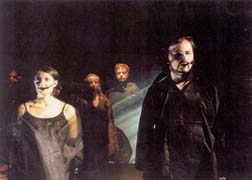
|
|
| "STRANGE BIRDS" AT DUMBO. | |
No, indeed. This name is an anagram for Down Underneath Manhattan Bridge Overpass. For years, those in the know have gone there—even before it got this catchy new name—for the fantastic East River view of Manhattan, framed by the Brooklyn and Manhattan Bridges.
At night, when the lights strung along the bridge cables are twinkling, the scene is especially striking. But it's not only this great view that has recently been attracting Manhattan artists and authors.
The former industrial area is solidly packed with spacious loft-buildings. And the former cheap rents have escalated, as the handsome lobbies and gleaming elevators indicate.
There's now even a grocery-store and a pub-restaurant. But the view is best enjoyed from KINO, an expansive and stylish new eatery right on the waterfront. It's expansive, not so expensive. I had super carrot soup and tasty truffle meatloaf.
But the first time I went down to DUMBO, I had no idea about the view. And there were no restaurants in sight.
My purpose was to follow the migration of an exciting and innovative performance group which calls itself GAle GAtes et al. The GAGA is a fond salute to founder Michael Counts' grandmother.
Its haunting evocation of the voyages of Ulysses after the Trojan War had been previously performed—simultaneously, in a variety of sites—on the entire floor of a Wall Street skyscraper.
It now has its own ground-level floor-through near the DUMBO waterfront. GAle GAtes' complicated and compelling So Long Ago I Can't Remember was the most recent major astonishment in these premises.
My most recent trip [F line subway, York Street station] took me to see what composer Joseph Diebes describes as a "chamber opera."
It is titled Strange Birds, apparently because Diebes is fascinated by the calls and songs of birds. He points out that their communicative calls are not the same thing as their songs.
Having digested this information, I was prepared for something birdlike in the music, song, and performances. Possibly even in the costuming and mise en scène, which is often a GAle Gates bizarre specialty.
This was not to be. Instead of vocalise, suggesting wordless birdsong, Diebes had his four black-clad singers use solfeggio, the repetitions of do-fa-sol on appropriate notes.
Unfortunately, this becomes tiresome, especially when the score is not hypnotic, which the strongly contrasting works of Philip Glass most often are.
The orchestral underscoring did not enhance the effect, for Diebes had created it—apparently live at each performance—by recording snippets or nano-seconds of orchestral music from his collection of records. He even included record-scratches, which was not a great idea.
Galienne Eriksen, Vielka Kelly, Daniel Neer, and John Rose were the thoroughly dedicated singers, variously moving and standing among translucent panels and smoke.
Other Entertainments—
New Victory: Martha & Life Is Rhythm [***/***]
As the actuality of New Forty-Two emerges/develops, the bizarre and garish threatens to eclipse—even to engulf—what survives from the Theatre Block's both splendid and sordid past.Reuters and the new high-rise rushing to completion on the south side of the intersection of 7th Avenue and 42nd will be fairly sedate Post-Modernist structural bookends for the eastward end of the block.
The riot of Entertainment Walk signs, slogans, and electronic screens at the other end of the uptown side, however, is Las Vegas trashy without the style and panache of Vegas Signage.
What the New York Times will unveil on the parking-lot opposite E-Walk is anyone's guess. Frank Ghery has proposed some very flamboyant structures for the site.
The pristine Art Deco/Art Nouveau New Amsterdam is swamped in vivid Yellow & Black Lion King visuals. Mme. Tussaud's Golden Hand and other south-side extravagances virtually conceal the fact that there are some historic facades behind/underneath all that glittering signage.
At least you won't be raped and robbed in some dark 42nd Street doorway as you might have been only ten years ago…
Meanwhile, Onstage at the New Victory…
Only the handsome and vintage New Victory Theatre stands pristine and supreme in its historic facade, wonderfully restored by architect Hugh Hardy and a host of craftsmen.
Once David Belasco's flagship theatre, the New Victory now specializes in short runs of productions designed to appeal primarily to young audiences. But with even broader appeals to parents and young-in-heart seniors.
Some of its shows, such as Shock-Headed Peter, could have well sustained Broadway runs. In fact, this wildly inventive production was recently shown in London's West End at the Piccadilly Theatre!
Barcelona's Catalan Camut Band certainly had something for all ages with its recent program, Life Is Rhythm. African and Latino beats captivated both kids and adults, with toe-tapping in the audience as well as on stage.
The rhythmic shh-shh of dancing feet shuffling in sand was highlighted by the performing persona of Guillem Alonso, with Jordi Satorra drumming. The choreographer/dancer talents of Rafael and Lluís Mendez—founders of the Camut Band—were stunning stage-revelations.
Japanese Buto dancers and Kodo drummers aren't the only ones to hypnotize audiences with the rhythmic pounding of Big Drums. The Camut Band should soon return to New 42 and the New Victory.
Quite a change of pace was Martha, a puppetry production of the Catherine Wheels Theatre Company. Martha is a crusty seashore Loner living an obsessive anal-retentive life in a ramshackle shack.
Embodied by Gill Robertson, she's not a puppet, but her daily routine is almost robotic. One remove from a puppet.
Her only human contact is the village Postman, played by Jay Manley. He also manipulates the puppet-goose who invades Martha's shack and life.
She tries to shut him out, but he beaks his way into her almost calcified heart. When instinct tells him he has to join a flock of geese flock flying south, she realizes she needs to rejoin her own flock, the people of the village. Both the puppetry and the unfolding shack were ingenious and amusing.
Next up at the new Victory is Tom's Midnight Garden!
At LaMaMa: RENO & Rhythms in the Light [****/*]

|
|
| RENO AT LaMAMA--"Rebel Without a Pause," and she really means it! Photo: ©Robin Holland/2001 | |
Some have moved on from the tiny ground-floor theatre at 74a East Fourth Street to the nearby LaMaMa Annex. Andrei Serban began in the basement!
But the LaMaMa vanguard has moved onward—by degrees—to the Public Theatre, to Lincoln Center, and to Broadway. And on to Hollywood in one direction, or Europe in the opposite. Or to Africa, Asia, and the other Americas…
Some never made it to the Great White Way—nor was that move ever part of their Creative Dreamtime. Instead, their innovative work has been given whole chapters—or at least paragraphs—in Theatre History!
Even more notable is the fact that this is LaMaMa's FORTIETH ANNIVERSARY SEASON! The Metropolitan Opera, of course, passed that milestone some time ago. But even the Met had seasons in which survival was in question.
There's a very big difference, however, between major performing arts organizations—with Millionaire Boards and Budgets—and Off-Off-Broadway institutional theatres like LaMaMa. With no Daddy Warbucks patrons—but with ambitious ongoing production programs.
Even those innovative theatre ensembles like Circle Rep and Circle in the Square—which had impressive rosters of wealthy patrons—ultimately failed. In both cases, sadly, the failure was not only in funding, but also in artistic vision.
Other groups, like the Impossible Ragtime Theatre and CSC—under Chris Martin and Karen Sunde—despite their admirable production choices and actual stagings, finally just "wore out." Fund-raising and Fighting the Board became major efforts, at the expense of energies which should have gone into production.
The New York Lifespan of a number of excellent Alternative Theatres has been about ten years or so. How Ellen Stewart has managed to "keep on trucking" is a wonder!
One of the treats of the new season is Reno in Rebel Without a Pause. Her upfront comments on the State of Downtown Manhattan—and of the nation as well—in the wake of the World Trade Center bombings proved pert and pertinent.
Immediately after the disaster, it was generally agreed that Irony Was Dead. And that Socio-Political Comedy was In Remission.
There were even those old enough to Remember Pearl Harbor and the World War II slogan: "Loose Lips Sink Ships." Fortunately, those who would like to revive wartime censorship—and trade the defunct Cold War for a very hot one—don't go to LaMaMa.
Even so, Reno ruffled some feathers. She's not a great admirer of the Nation's CEO. And she thinks Mayor Giuliani should have kept that Saudi check. That rejecting it was Political Grandstanding.
Reno had jotted down some notes on pet and recent peeves. Almost all these improvs proved interesting and often amusing. But she could profit from an editor-director's assistance in honing her routines.
Off-the-Cuff may well be a LaMaMa Style, but—after 40 years at the same stand—how could some structure and shaping hurt concepts and substance?
This was certainly a problem with the one-man show of Ducarmo Alexandrino, a soi-disant Brazilian "performance artist." He called his strange collage of words, movement, music, costumes, and props: Rhythms in the Light.
According to the press-release—which induced me to make the long trek down to East 4th Street—his show was "reflecting on the complexity and beauty of life." Wow! That's a tall order!
This goal proved beyond his ego-centric vision and performance resources. Even Martha Graham found these goals challenging…
His attempts at audience-interaction I found embarrassing: Almost pathetic pleas for approval and even love. But I did not walk out as did some.
Q&A: Are You Dave Gorman? [***]
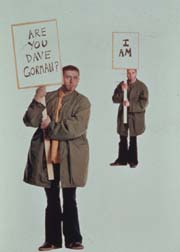
|
|
| THE SEARCH GOES ON--Dave Gorman looks for more Dave Gormans | |
Dave is a manic, intense, and very funny fellow who writes comedy for British TV. His current one-man Inquisition was shown this past summer in the Edinburgh Fringe Festival.
I missed it as there seemed to be something like 300 stand-up comics on view. So I opted for plays, opera, and dance performances instead. With Richard Wagner and Williams Shakespeare, you have some idea of the content beforehand…
Dave Gorman has been traveling far and wide to find others who bear his name. He takes a Polaroid photo of them and asks them to introduce themselves on what is surely the most antiquated hand-held recorder.
The sound is terrible. Maybe that's part of Gorman's obsessively amateurish conceit?
He logs the miles it has taken him to reach his various Dave Gormans. Then he works out the Miles Per Gorman Factor.
Frankly, I didn't find the conceit or the substance all that amusing. But Gorman in performance is so intense and crazy that he is ultimately entertaining.
Random Round-Up:
Curtain Up!
Lincoln Center's New York Public Library
For the Performing Arts Re-opens!
After a three-year closure and a $37 million expenditure, the Lincoln Center Library for the Performing Arts has just had its gala re-opening. Originally designed as a kind of square concrete doughnut—enfolding the Vivian Beaumont Theatre complex, it appears unchanged outside. But, thanks to James Polshek and Partners, it has been wonderfully reconfigured inside. This re-design will make preservation, cataloguing, servicing, and all aspects of performing arts research much easier.
Instead of having to sign for a videotape of a Broadway show and play it yourself on one of the old video-monitors, all video and audio performance records will now be played from a central source.
Formerly, Theatre, Dance, Music, and Recorded Sound each had a separate research section. Now all the special divisions are serviced in one grand room stretching the length of the building.
In line with recent advances in online preservation and distribution of print, graphic, and photographic materials, many of the invaluable but ageing archival documents will be made available over time in this indestructible form.
Anyone who has had an old Brooks Atkinson review crumble in his/her fingers will be glad of that. And now there will be photocopy machines easily available on each floor as well.
At the Lincoln Plaza entrance—where once people listened to records and waited for friends, there is now the spacious Donald and Mary Oenslager Gallery. Its attractively designed exhibitions will be open until 8 pm, to permit theatre and opera-goers to enjoy the displays.
[One of America's premier theatre designers, Oenslager also left an extremely valuable collection of historical prints & drawings to the Morgan Library. And The Museum of the City of New York has some original Oenslager designs and models as well.]
The Vincent Astor Gallery, on the Amsterdam Avenue side of the complex, has been redesigned. Not only will it continue to provide small-scale exhibitions, but it can now also accommodate meetings and seminars.
Even the Bruno Walter Auditorium has been updated and improved. So, if you can't afford the Met—or the City Opera is sold-out—you could see and hear something fascinating in this handsome space. Often for free!
You can check all this out—and much else about the 42nd Street NYPL Research Collections as well—at this web-address: www.nypl.org
Here & There on Institutional Stages—
At the Juilliard School, the Drama Division recently presented two interesting student productions. John Guare's strangely surveyed Landscape of the Body was revived by that talented director, Will Pomerantz, with an able cast.But the young "Stars of Tomorrow" were more compelling in actor Laurence Fishburne's raffish and deadly drug-drama, Riff Raff, set in an almost demolished tenement apartment. Staged by Regge Life, it featured Frank Harts, Wayne Scott, and Daniel Breaker.
At the Japan Society —in handsome quarters near the United Nations—the Kaitaisha Theatre Company presented Bye-Bye: The New Primitive. It was self-indulgent slow-motion Asian Water-Torture. But the post-performance sushi vanished very swiftly.
Unfortunately, I won't be able to report on the Society's next offerings, Suzuki's Electra and Oedipus the King. His innovative and unusual Japanese visions of Shakespeare's tragedies and other classics of drama are internationally admired, so these performances were sold-out before anyone noticed there were no press-tickets left.
On the shallow lecture-stage of the sedate auditorium of the New-York Historical Society, the Actors Company Theatre—ACT, for anagramatic ingenuity—revived Jean Anouilh's The Waltz of the Toreadors.
Their generally excellent productions are in essence staged-readings, but as they are in costume, in character, and often almost book-free, they do make the scripts live again. There is no room on the platform for acting in depth, but with plenty of passion—and some musical accompaniment—this reincarnation of Anouilh's sentimentally acid comedy of aging affinities was impressive.
Cynthia Harris and James Murtagh struck sparks as the tyrannical Mme. St. Pé and her "garbage-can/boite des ordures" of a husband, General St. Pé. Frankly, I liked them better than Anne Jackson and Eli Wallach, who created the roles on Broadway years ago. Simon Jones was philosphically charming as "the Other Man."
Less dramatically effective as a staged-reading was Riot at the Opera House! This recreated the shameful 1849 Astor Place Riot. The riot was incited mainly by angry young Irish immigrants who championed the virile acting of America's Edwin Forrest against the effete acting style of England's William Macready.
Drafted by Andrew Davis—from contemporary court-records, newspaper accounts, diaries, and letters—it was initially performed in 1999 at the Cooper Union on Astor Place to commemorate the 150th anniversary of that fatal riot. It was recently revived, but with a rather unprofessional cast.
It was presented at the CUNY Graduate Center —now in the old B. Altman Building on Fifth Avenue. It was a high-point of the timely and wide-ranging Gotham Center Conference on New York City History.
CUNY Grad Center Theatre PhDs at Work:
Among the many outstanding CUNY Graduate Center graduates from the PhD in Theatre Program are my colleagues and friends, Dr. Elizabeth Swain & Dr. Richard Helfer.So this seems an appropriate CUNY connection for mentioning Liz Swain's interesting recent staging of Wendy Kesselman's musical tale of two young women caught up in the French Revolution, The Executioner's Daughter. This was presented at Marymount Manhattan College, where Professor Swain shares her expertise in acting and directing with talented students.
Also of interest was the admirably performed staged-reading at Ensemble Studio Theatre of Helfer's new drama, Mount Saint Helens, focusing on Harry Truman.
Not the late President, but the lodge-keeper who stubbornly refused to abandon the slopes of that fatal volcano. This script would, I believe, make an effective film.
Richard Helfer has also made several interesting translations of great French Neo-Classic dramas of Corneille and Racine. Not to overlook his provocative period-drama, Poisons, which certainly should be given a major production.
The fact that he was one of the excellent student-colleagues in my CUNY theatre-seminar on the career of Peter Brook—and co-edited the proceedings with me as Peter Brook: From Oxford To Orghast —in no way affects my admiration of his work as a playwright and translator.
And it just so happens that he is the Executive Editor of Modern Theatre Online —of which I'm Project Director—for the NYU Center for Advanced Technology. How's that for Disclosure?
Questioning Women Who Write Plays:
Another outstanding graduate of CUNY's PhD in Theatre Program is Dr. Alexis Greene. She collaborated with Julie Taymor on Pride Rock: The Lion King on Broadway. And she is a much-respected drama critic and dramaturg. In fact, she's the co-founder of the Literary Managers and Dramaturgs of America.Currently, she's demonstrating her journalistic skills with her book of interviews with especially interesting American dramatists: Women Who Write Plays. It's published by Smith & Kraus [543 pp., $19.95] with a December publication-date. It should be in drama bookstores even before then. If not, try this email address: sandk@sover.net
Alexis Greene's focus on women writers is not sexist, but it is certainly gender-oriented. This is so not only because women playwrights tend to get less attention from the predominantly male reviewing corps.
But also because there are so many unresolved social, political, cultural, and emotional issues which immediately concern women—and mothers—in ways of which many men are largely unaware. Or to which they are indifferent…
Some of Greene's interview-subjects are already fairly well known, with major Broadway and Off-Broadway credits. Beth Henley, Tina Howe, and Paula Vogel are especially forthright in their conversations with Greene.
Other authorial talents are better known in regional theatres or in New York's Off-off fringe. The Public Theatre has been notably welcoming to some of these women playwrights. Among my favorites are Constance Congden, Diana Son, and the 5 Lesbian Brothers.
Eve Ensler, of Vagina Monologues notoriety, speaks her piece, as does director/author Emily Mann. Serious playgoers will also recognize the names of Lynn Nottage, Elizabeth Egloff, Kia Corthron, Carmen Rivera, and Naomi Wallace—who has shown outstanding work at the Humana Festival.
Wendy Kesselman—whose The Executioner's Daughter has just been staged at Marymount Manhattan—is more interesting discussing the long genesis of that musical drama than she proves to be onstage in the actual text.
Curiously, that more famous Wendy playwright, Wendy Wasserstein, is absent from this copious collection. But commercial success is hardly Greene's touchstone in this anthology of interviews.
Leafing through various interviews, it soon becomes apparent that Greene is far more interested in experimental work than in mainstream theatre-formulas.
Her format is Question & Answer, but—unlike some interviewers, who let their own questions run on and on in print —Greene generally limits herself to terse but provocative questions.
As she is very witty—often ironic—and knowledgeable herself, I can well imagine that there was far more Greene/Subject interaction in the actual interviews. But she knows that potential readers want to hear what the playwrights have to say, not what the interviewer thinks of them and their work.
Greene does introduce each interview with a brief and often revelatory bio. But the text which follows often reads like an extended monologue, with occasional verbal prods to keep the creative flow surging onward. [Loney]
Copyright © Glenn Loney 2001. No re-publication or broadcast use without proper credit of authorship. Suggested credit line: "Glenn Loney, New York Theatre Wire." Reproduction rights please contact: jslaff@nytheatre-wire.com.
| museums | recordings | coupons | publications | classified |